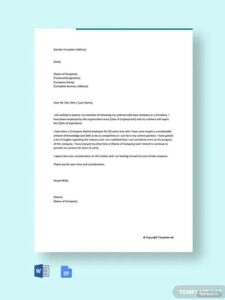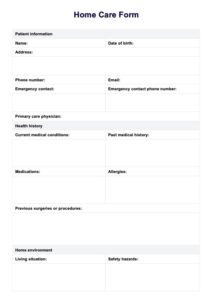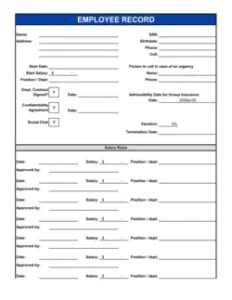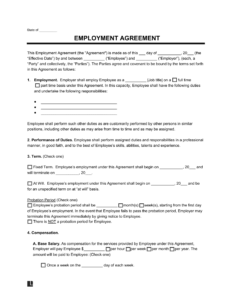As businesses evolve and projects take new directions, the agreements with your valued team members often need to follow suit. Employment contracts are the backbone of a clear working relationship, defining responsibilities, compensation, and the duration of an engagement. When these contracts near their expiration, a crucial step arises: deciding whether to renew them and communicating that decision effectively. This process, while seemingly straightforward, carries significant weight for both the employer and the employee.
Navigating contract renewals with clarity and professionalism is paramount to maintaining a positive workplace and ensuring legal compliance. This is where a well-crafted communication becomes invaluable. Utilizing a robust employment contract renewal letter template can streamline this process, providing a structured framework that ensures all necessary details are covered, misunderstandings are minimized, and the transition into a renewed term is as smooth as possible. It’s about being prepared and communicating clearly from the outset.
Crafting the Perfect Renewal Letter: Essential Components
Sending an employment contract renewal letter isn’t just a formality; it’s a critical communication that sets the stage for the next phase of an employee’s journey with your organization. A thoughtfully composed letter ensures legal clarity, professional courtesy, and a clear understanding of the new terms for all parties involved. This isn’t a one-size-fits-all document, but rather a guide that needs careful customization to reflect the specific circumstances of each employee and the evolving needs of your company.
The power of a good template lies in its ability to remind you of all the crucial information that absolutely must be included. Missing even one small detail can lead to confusion or, worse, potential legal issues down the line. Therefore, building your letter with a clear checklist of components is not just helpful, it’s essential for a smooth and compliant process. It acts as your backbone for ensuring consistency and thoroughness.
Key Information to Include
When you begin to draft your renewal letter, think of it as a clear roadmap for the employee. Every piece of information serves a purpose, guiding them through the offer and what comes next.
-
Employee and Employer Details: Start with the basics. Ensure the full legal names, addresses, and contact information for both the employee and the employer are explicitly stated at the top of the letter. This clearly identifies who is sending and receiving the communication.
-
Reference to the Original Contract: To avoid any ambiguity, clearly reference the original employment contract. Include its start date and the upcoming expiration date. This provides immediate context for the renewal offer and links it back to the existing agreement.
-
The Offer of Renewal: This is the core message. Clearly state that you are offering to renew the employment contract, specifying the proposed new duration (e.g., for another year, an indefinite period) and the effective start date of this renewed term.
-
New Terms and Conditions (If Any): This section is vital. If there are any changes from the original contract—whether it’s an adjustment to salary, new job responsibilities, a change in working hours, or updated benefits—these must be clearly and concisely outlined. If the terms remain exactly the same, state this explicitly and mention that the original contract terms (or an attached new contract) will apply, with only the duration being extended.
-
Next Steps and Call to Action: Guide the employee on how to accept the renewal offer. This often involves signing and returning a copy of the letter, or a new, updated contract by a specified deadline. Provide clear instructions and contact information for any questions they might have.
Ensuring each of these elements is present and clearly articulated not only streamlines the administrative process but also fosters transparency. An employee who understands precisely what is being offered and what is expected of them is more likely to accept the renewal with confidence and continue to be a productive member of your team. This detailed approach builds trust and reinforces a professional relationship from the outset.
Best Practices for a Smooth Renewal Process
Beyond the contents of the letter itself, the overall process of contract renewal significantly impacts employee relations and legal standing. Approaching renewals strategically and thoughtfully can prevent misunderstandings, alleviate anxiety for employees, and ensure your organization remains compliant and efficient. It’s not just about sending a letter; it’s about managing a transition.
One of the most crucial elements is timing. Waiting until the eleventh hour to address an expiring contract can create unnecessary stress for both parties. Proactive communication, well in advance of the expiration date, demonstrates respect for your employee and allows ample time for consideration, discussion, and any necessary adjustments to the terms. This forward-thinking approach creates a much more positive experience.
Even with the perfect employment contract renewal letter template in hand, customization remains key. Each employee’s situation might be unique, perhaps involving discussions about career growth, performance reviews, or specific changes in their role. While the template provides a solid foundation, take the time to personalize the letter and, if appropriate, follow up with a conversation. This human touch reinforces the employee’s value to the company.
For any significant changes to terms, or if you’re operating in a jurisdiction with complex labor laws, seeking legal advice before finalizing and sending renewal letters is always a wise decision. A legal professional can review the proposed terms and language to ensure compliance and mitigate potential risks. This step provides an essential layer of protection for your business.
-
Communicate Early: Initiate renewal discussions several weeks, or even months, before the contract’s expiration. This respectful lead time allows the employee to consider the offer and provides an opportunity for any necessary negotiations or clarifications.
-
Personalize the Communication: While a template is a great start, always tailor the letter to the individual employee. Reference their contributions, highlight positive performance, and make the communication feel personal rather than generic.
-
Offer a Discussion: Beyond the written offer, consider offering a brief meeting to discuss the renewal. This provides a platform for the employee to ask questions directly, express any concerns, and feel heard, fostering a stronger sense of engagement.
-
Maintain Meticulous Records: Keep a comprehensive record of all communication related to contract renewals, including sent letters, signed acceptances, and any follow-up discussions. This documentation is invaluable for future reference and legal compliance.
By integrating these best practices into your renewal process, you transform a routine administrative task into an opportunity to strengthen employee relationships and underscore your commitment to fair and transparent employment practices. It demonstrates professionalism and a thoughtful approach to managing your most valuable assets: your people.
Ensuring clarity and professionalism in all your employment communications, especially when it comes to renewals, is a hallmark of a well-run organization. Utilizing structured tools and following best practices not only simplifies the administrative burden but also significantly contributes to a positive and legally sound working environment. It helps maintain the trust and confidence of your team, ensuring that both parties are aligned and secure in their ongoing professional relationship.
A well-executed contract renewal process reflects positively on your company culture and its commitment to its workforce. It underscores your dedication to fair labor practices and clear communication, paving the way for continued success and stability within your team. Ultimately, transparent and organized renewals contribute to a healthier, more productive, and harmonious workplace for everyone involved.



